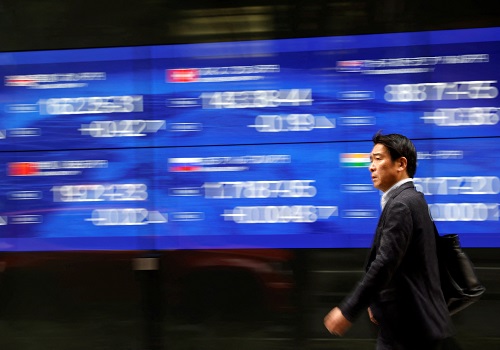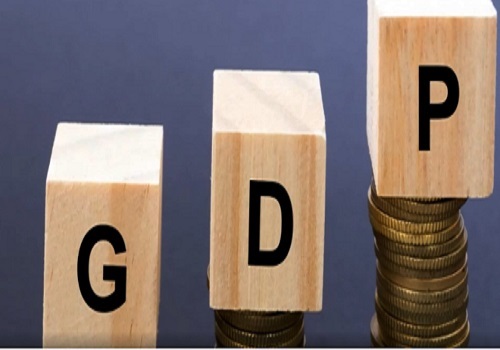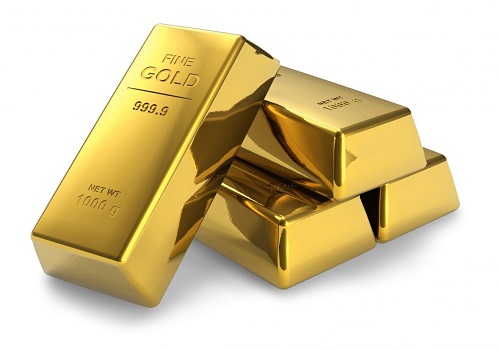Jeera trading range for the day is 22560-24760 - Kedia Advisory

Gold
Gold prices showed a modest uptick, settling at 65608, as investors awaited key central bank meetings, particularly the U.S. Federal Reserve's policy decision, to gauge insights into inflation and interest rates. Data indicating solid increases in U.S. consumer and producer prices underscored inflation concerns, influencing market sentiment. Expectations of the Bank of Japan exiting its ultra-dovish monetary policy further contributed to market anticipation. However, the Bank of England is anticipated to maintain rates during its meeting on Thursday. In anticipation of the Fed's meeting, markets priced in a 55% chance of a rate cut in June, although no immediate changes are widely expected. Despite this, physical gold demand in Asia dwindled due to elevated prices, prompting dealers to offer significant discounts. In China, gold premiums decreased to $15-$25 per ounce, the lowest since July, while Indian dealers offered discounts of about $36 per ounce, the highest since March 2023. Singapore and Hong Kong witnessed varying premiums, while in Japan, gold was sold at par to minimal premiums. Technically, the gold market experienced short covering, with a decrease in open interest by -3.69% to settle at 13317. Prices rose by 66 rupees. Presently, gold finds support at 65290, with a potential test of 64975 upon breaching. Resistance is anticipated at 65810, with a potential move above leading to a test of 66015.
Trading Ideas:
* Gold trading range for the day is 64975-66015.
* Gold prices firmed as investors awaited a series of central bank meetings this week
* Fed interest rate decision due on Wednesday
* Traders see 55% chance of a June US rate cut
Silver
Silver prices experienced a modest decline of -0.2% yesterday, settling at 75496, as investors awaited major central bank policy meetings later in the week. While most regulators are expected to maintain current interest rates, market attention is focused on potential signals for the initiation of monetary easing. Mixed economic data from the US led to adjustments in expectations for a June interest rate cut by the Fed to around 55%, dampening the appeal of non-yielding assets like silver. However, silver found support from escalating geopolitical tensions and an improved industrial outlook in China, the world's top metals consumer. China reported better-than-expected growth in industrial production, fixed asset investment, and retail sales, bolstering silver's industrial demand outlook. On the flip side, manufacturing activity in the New York region took a hit this month, with the New York Federal Reserve's Empire State manufacturing survey plummeting to -20.9 in March, well below expectations and February's reading. Despite this, U.S. import prices saw a marginal increase in February, partly due to higher petroleum product costs, which could impact the inflation outlook positively. In India, banks halted silver imports after private traders capitalized on lower duties by purchasing significant volumes from the United Arab Emirates. Technically, the silver market witnessed long liquidation, with a -0.26% drop in open interest to settle at 26339, accompanied by a decline of -154 rupees in prices. Currently, silver finds support at 75140, with potential downside targets at 74780, while resistance is expected around 75905, with a potential breakout leading to testing 76310 levels.
Trading Ideas:
* Silver trading range for the day is 74780-76310.
* Silver traded flat as investors held their breath ahead of policy meeting of major central banks.
* Most regulators are anticipated to leave their current interest rates untouched.
* Mixed economic data from the US prompted the readjustment of bets on June interest rate cut by the Fed to around 55%.
Crude oil
Crude oil prices surged by 1.85% yesterday, settling at 6844, driven by escalating geopolitical tensions that continued to raise concerns about global supply. Ukraine's intensified drone strikes on Russian oil refineries, leading to approximately 7% of Russian refining capacity being idled in the first quarter, contributed significantly to these supply concerns. Morgan Stanley revised its Brent oil price forecasts upward by $10 per barrel to $90 for the third quarter of 2024, citing tighter supply and demand balances due to OPEC+ commitments and Russia's production cuts following the recent drone attacks on its refineries. Additionally, the bank adjusted its supply forecasts for OPEC and Russia downward by 0.2-0.3 million barrels per day for the second and third quarters, anticipating deficits in both periods. Iraq's announcement of reducing crude exports to 3.3 million barrels per day in the coming months to comply with its OPEC+ quota further added to the supply outlook. The commitment to voluntary cuts underscores efforts to stabilize global oil markets amidst uncertainties. Meanwhile, Saudi Arabia's crude oil exports decreased to 6.297 million barrels per day in January, down slightly from December, according to official data, indicating the kingdom's continued adherence to production quotas. From a technical perspective, the crude oil market saw short covering, with a significant decrease in open interest by -34.55% to settle at 2245. Prices surged by 124 rupees, indicating strong buying momentum. Presently, crude oil finds support at 6761, with a potential test of 6678 upon breaching. Resistance is anticipated at 6891, with a possible move above leading to a test of 6938.
Trading Ideas:
* Crudeoil trading range for the day is 6678-6938.
* Crude oil gains as heightened geopolitical risks continued to spark supply concerns.
* Morgan Stanley raised its Brent oil price forecasts by $10 per barrel to $90 for the third-quarter of 2024
* Iraq to curb oil exports to 3.3 mbpd in coming months
Natural gas
Natural gas saw a notable uptick of 2.46% yesterday, settling at 141.7, primarily driven by forecasts indicating colder weather and heightened heating demand over the next two weeks. This shift in weather projections, coupled with a sustained decrease in U.S. output following the collapse of gas prices in February to a 3-1/2-year low, buoyed market sentiment. In February, prices had plummeted to $1.511 per mmBtu, their lowest since June 2020, as abundant output and mild weather allowed for significant gas storage accumulation, outweighing heating demand. Despite the recent lows, expectations for record-high U.S. gas consumption in 2024 have emerged, although this has led to a reduction in production for the first time since 2020, according to the U.S. Energy Information Administration (EIA). Gas output in the Lower 48 U.S. states dipped to an average of 100.3 billion cubic feet per day (bcfd) in March, down from 104.1 bcfd in February. Meteorologists foresee colder-than-normal weather across the Lower 48 states until March 25, followed by a shift towards near- to warmer-than-normal conditions from March 26 to April 2. Despite these fluctuations, financial firm LSEG projects gas demand in the Lower 48 states, including exports, to remain steady around 113.5 bcfd over the next week. Technically, the market exhibited short covering behavior, with a -3.93% drop in open interest to settle at 60486, accompanied by a price increase of 3.4 rupees. Presently, natural gas finds support at 138.2, with potential downside targets at 134.8, while resistance is anticipated around 145.7, with a potential breakout leading to testing 149.8 levels.
Trading Ideas:
* Naturalgas trading range for the day is 134.8-149.8.
* Natural gas jumped on forecasts for colder weather
* Support also seen on a continued drop in U.S. output after gas prices collapsed to a 3-1/2-year low in February.
* Gas output in the Lower 48 U.S. states fell to an average of 100.3 bcfd so far in March
Copper
Copper prices edged higher by 0.45% yesterday, settling at 765.7, buoyed by robust Chinese economic data, igniting optimism for a resurgence in demand from the world's largest consumer of top metals. China's industrial output surged by 7% annually in January and February, surpassing expectations, while retail sales saw a notable increase of 5.5%. This positive momentum was further bolstered by top Chinese copper smelters' decision to curtail production at unprofitable facilities due to raw material shortages, which had led to a significant drop in copper concentrate prices to a decade low, impacting smelters' profitability. Despite these encouraging indicators, concerns linger regarding the real estate sector, with property investment declining by 9% during the same period. While this marks an improvement from December's 24% decline, it underscores ongoing challenges within the sector. The International Copper Study Group (ICSG) reported a surplus of 20,000 metric tons in the global refined copper market for December, compared to a deficit of 123,000 metric tons in November. However, for the first 12 months of the year, the market remained in a deficit of 87,000 metric tons, a decrease from the 434,000 metric tons deficit seen in the same period a year earlier. December witnessed world refined copper output at 2.39 million metric tons, slightly surpassing consumption at 2.37 million metric tons. From a technical standpoint, the copper market experienced short covering, with a notable decrease in open interest by -9.01% to settle at 3536. Prices saw an increase of 3.45 rupees. Presently, copper finds support at 760.7, with a potential test of 755.5 upon breaching. Resistance is anticipated at 769.9, with a possible move above leading to a test of 773.9.
Trading Ideas:
* Copper trading range for the day is 755.5-773.9.
* Copper gains as buoyant Chinese economic data fostered hopes for a recovery in demand.
* Chinese copper smelters agreed to reduce production at facilities that were unprofitable due to shortages of raw materials
* China's industrial output soared by 7% annually throughout January and February.
Zinc
Zinc prices experienced a decline of -0.76% yesterday, settling at 220.95, influenced by developments in production and demand dynamics. Notably, Glencore's Nordenham zinc smelter in Germany, which had been under care and maintenance for over a year, resumed production last month. This resumption added to the global zinc supply, potentially contributing to the downward pressure on prices. In China, industrial output exceeded expectations, growing by 7% annually over January and February, while retail sales also showed positive growth at 5.5%. However, concerns lingered over the real estate sector, with property investment declining by 9% over the same period, albeit at a slower pace compared to December. Specifically regarding zinc, China's refined zinc output in February 2024 saw a decrease month-on-month, reflecting the impact of the Chinese New Year holiday and tightened zinc concentrate raw material supply. Domestic zinc alloy output also declined in February, with smelters facing closures for maintenance during the holiday period, coupled with delays in production resumption due to raw material shortages. Technically, the zinc market observed long liquidation, with open interest dropping by -6.12% to settle at 3267, alongside a decrease of -1.7 rupees in prices. Currently, zinc finds support at 219.7, with potential downside targets at 218.3, while resistance is expected around 223.2, with a potential breakout leading to testing 225.3 levels. Overall, while production resumptions and demand dynamics shape zinc's price trajectory, technical indicators suggest a cautious outlook amidst potential further price fluctuations in the market.
Trading Ideas:
* Zinc trading range for the day is 218.3-225.3.
* Zinc dropped as Glencore's Nordenham zinc smelter starts ramping up output
* China’s real estate remained a worry as property investment in the same period fell 9%
* In February 2024, China's refined zinc output was 502,500 mt, a month-on-month decrease of 64,400 mt or 11.36%.
Aluminium
Aluminium prices remained unchanged at 204.6, reflecting stability in the market amid upbeat data from China, reigniting hopes for increased demand. China's robust industrial activity, surpassing market expectations with a 7% year-on-year surge in January-February 2024, contributed to positive sentiment. Primary aluminium output in the first two months of 2024 also saw a notable increase of 5.5% compared to the same period a year earlier, driven by improved profits supporting production. China, the world's largest aluminium producer, produced 7.1 million metric tons of primary aluminium during January and February, buoyed by increased profit margins. Smelters benefited from higher profits, averaging 1,964 yuan per ton in February, marking a 50% increase from the previous year. However, concerns arose regarding declining profits due to higher alumina prices, a key raw material for smelters. Despite domestic production growth, China's imports of unwrought aluminium and related products surged by 93.6% compared to the previous year, reaching 720,000 tons. This surge in imports coincided with a notable increase in aluminium stocks monitored by SHFE warehouses, up by approximately 80% in February. Production in Yunnan, China's fourth-largest aluminium-producing region, remained constrained due to production curbs during the annual dry season. However, production is expected to resume as power supply conditions improve. From a technical standpoint, the aluminium market witnessed long liquidation, with a drop in open interest by -6.73% to settle at 3102, while prices remained unchanged. Presently, aluminium finds support at 204.1, with a potential test of 203.4 upon breaching. Resistance is anticipated at 205.5, with a possible move above leading to a test of 206.2.
Trading Ideas:
* Aluminium trading range for the day is 203.4-206.2.
* Aluminium settled flat as upbeat data from China reignited hopes for a surge in demand.
* China aluminium production up 5.5 % to 7.1 mln tonnes in Jan – Feb
* Industrial activity surged by 7% year-on-year in January-February 2024, exceeding market expectations of 5%.
Cottoncandy:
Cottoncandy prices saw a modest increase of 0.52% yesterday, closing at 61520, driven by an optimistic demand outlook and reduced ending stocks in the US. The Cotton Corporation of India (CCPC) raised its production forecast for the current season, reflecting an upward trend in cotton production expectations. However, despite the positive outlook, ICE prices experienced a decline due to increased supply expectations and reduced demand from mills. On the global front, Cotton Australia raised its production estimate, while US cotton forecasts showed lower production and ending stocks, indicating a potentially tighter supply-demand balance. This was further echoed in global supply and demand estimates for 2023/24, with higher production, consumption, and trade, but lower ending stocks. Despite the overall positive sentiment, the Southern India Mills’ Association (SIMA) cautioned textile mills against panic buying, noting a recent surge in domestic cotton prices. The association highlighted increased capacity utilization at mills and rising export contracts but warned that high domestic prices could dampen international demand. In the spot market, prices in Rajkot ended slightly lower, reflecting some localized market dynamics. Technically, the market observed short covering, with a -6.01% drop in open interest to settle at 266, coupled with a price increase of 320 rupees. Currently, Cottoncandy finds support at 61260, with potential downside targets at 61010, while resistance is expected around 61900, with a potential breakout leading to testing 62290 levels.
Trading Ideas:
* Cottoncandy trading range for the day is 61010-62290.
* Cotton gains helped by an improved demand outlook and lower ending stocks in US.
* Cotton Australia raised its estimate for Australian production this year to "at least" 4.5 million bales
* SIMA urges textile mills to avoid panic buying as cotton prices rise, global supply expected to increase post July.
* In Rajkot, a major spot market, the price ended at 29442.45 Rupees dropped by -0.04 percent.
Turmeric
Turmeric prices experienced a slight decline of -0.6% yesterday, settling at 17544, driven by profit booking following a period of positive bias fueled by below-normal supplies and active festive demand. The impact of lower production is evident in the slower arrival pace compared to the previous year, suggesting prevailing supply tightness may entice stockists to buy turmeric at every price dip. The seasonality of turmeric typically results in higher prices during March due to festive buying, and with a series of festivals ahead and the commencement of the wedding season, demand is expected to remain robust. However, production is forecasted to drop by about 14% year-on-year due to reduced area under turmeric cultivation and tumbling yields, expected to range between 9.2-9.5 lakh tonnes. Despite lower domestic production, turmeric exports during April-January 2024 declined by 3.52% compared to the same period in the previous year, reaching 131,662.92 tonnes. Conversely, turmeric imports during the same period dropped by 22.34%, indicating a decline in foreign procurement. From a technical standpoint, the turmeric market witnessed long liquidation, with a drop in open interest by -2% to settle at 15450, while prices decreased by -106 rupees. Presently, turmeric finds support at 17054, with a potential test of 16564 upon breaching. Resistance is likely at 18042, with a possible move above leading to a test of 18540.
Trading Ideas:
* Turmeric trading range for the day is 16564-18540.
* Turmeric dropped on profit booking after prices rose amid below normal supplies
* Festivals ahead in coming months and commencement of wedding season demand is likely to keep buyers engage.
* Production is likely to be dropped by about 14% Y-o-Y due to lower area under turmeric.
* In Nizamabad, a major spot market, the price ended at 16603 Rupees gained by 0.43 percent.
Jeera
Jeera prices faced a substantial decline of -3.99% yesterday, settling at 23465, driven by a surge in jeera acreage during the current rabi season. Farmers in key producing states like Gujarat and Rajasthan expanded cultivation, encouraged by record prices in the previous marketing season. The significant increase in acreage, particularly in Gujarat, where cultivation covered 5.60 lakh hectares, and Rajasthan, with a 25% increase, indicates a strong response to market signals. However, despite the expanded acreage, support for prices emerged due to emerging weather risks in Rajasthan and Gujarat, potentially affecting yields adversely. Challenges such as lower water availability, fewer cold days, and concerns about pest attacks further contribute to market uncertainties. Additionally, global demand for Indian jeera declined as buyers shifted preferences towards other origins like Syria and Turkey due to comparatively higher prices in India. This trend is expected to persist, impacting export volumes in the upcoming months. Export data revealed a decline of 25.33% in jeera exports during Apr-Jan 2024 compared to the previous year, reflecting subdued global demand. However, there was a slight uptick in exports in January 2024 compared to December 2023 and January 2023, suggesting some seasonal variability. In the spot market, prices in Unjha ended slightly higher, indicating localized market dynamics amidst broader price declines. Technically, the market witnessed fresh selling pressure, with a 1.52% increase in open interest to settle at 2811, accompanied by a significant price decrease of -975 rupees. Currently, Jeera finds support at 23020, with potential downside targets at 22560, while resistance is expected around 24120, with a potential breakout leading to testing 24760 levels.
Trading Ideas:
* Jeera trading range for the day is 22560-24760.
* Jeera prices dropped as jeera acreage hits a four-year high
* Support also seen in wake of emerging weather risk in Rajasthan and Gujarat that may affect the yield.
* Stockists are showing interest in buying on recent downfall in prices triggering short covering.
* In Unjha, a major spot market, the price ended at 26140.85 Rupees gained by 0.35 percent.
Views express by all participants are for information & academic purpose only. Kindly read disclaimer before referring below views.
























